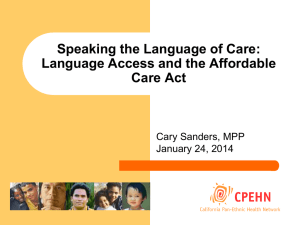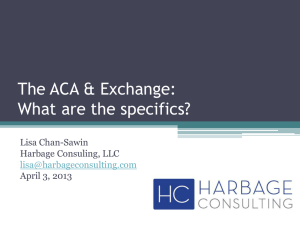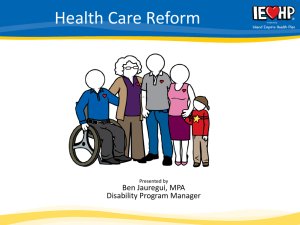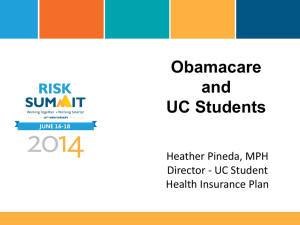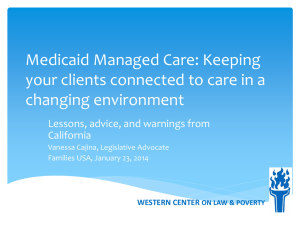ObamaCare 101: Frequently Asked Questions Updated October 15
advertisement
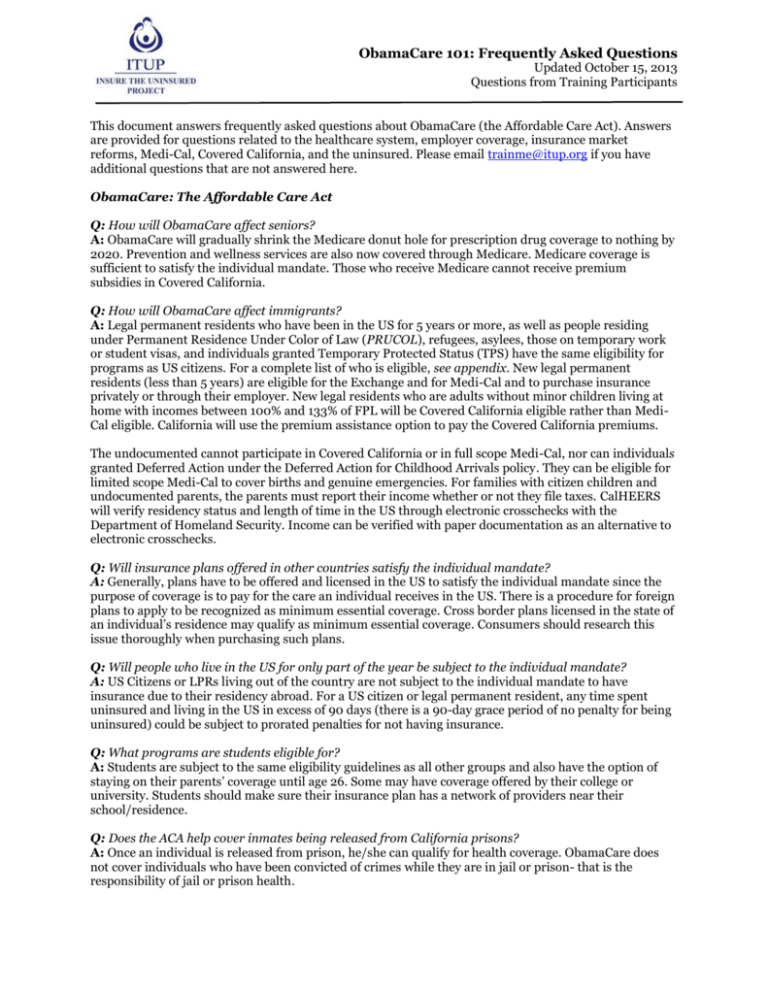
ObamaCare 101: Frequently Asked Questions Updated October 15, 2013 Questions from Training Participants This document answers frequently asked questions about ObamaCare (the Affordable Care Act). Answers are provided for questions related to the healthcare system, employer coverage, insurance market reforms, Medi-Cal, Covered California, and the uninsured. Please email trainme@itup.org if you have additional questions that are not answered here. ObamaCare: The Affordable Care Act Q: How will ObamaCare affect seniors? A: ObamaCare will gradually shrink the Medicare donut hole for prescription drug coverage to nothing by 2020. Prevention and wellness services are also now covered through Medicare. Medicare coverage is sufficient to satisfy the individual mandate. Those who receive Medicare cannot receive premium subsidies in Covered California. Q: How will ObamaCare affect immigrants? A: Legal permanent residents who have been in the US for 5 years or more, as well as people residing under Permanent Residence Under Color of Law (PRUCOL), refugees, asylees, those on temporary work or student visas, and individuals granted Temporary Protected Status (TPS) have the same eligibility for programs as US citizens. For a complete list of who is eligible, see appendix. New legal permanent residents (less than 5 years) are eligible for the Exchange and for Medi-Cal and to purchase insurance privately or through their employer. New legal residents who are adults without minor children living at home with incomes between 100% and 133% of FPL will be Covered California eligible rather than MediCal eligible. California will use the premium assistance option to pay the Covered California premiums. The undocumented cannot participate in Covered California or in full scope Medi-Cal, nor can individuals granted Deferred Action under the Deferred Action for Childhood Arrivals policy. They can be eligible for limited scope Medi-Cal to cover births and genuine emergencies. For families with citizen children and undocumented parents, the parents must report their income whether or not they file taxes. CalHEERS will verify residency status and length of time in the US through electronic crosschecks with the Department of Homeland Security. Income can be verified with paper documentation as an alternative to electronic crosschecks. Q: Will insurance plans offered in other countries satisfy the individual mandate? A: Generally, plans have to be offered and licensed in the US to satisfy the individual mandate since the purpose of coverage is to pay for the care an individual receives in the US. There is a procedure for foreign plans to apply to be recognized as minimum essential coverage. Cross border plans licensed in the state of an individual’s residence may qualify as minimum essential coverage. Consumers should research this issue thoroughly when purchasing such plans. Q: Will people who live in the US for only part of the year be subject to the individual mandate? A: US Citizens or LPRs living out of the country are not subject to the individual mandate to have insurance due to their residency abroad. For a US citizen or legal permanent resident, any time spent uninsured and living in the US in excess of 90 days (there is a 90-day grace period of no penalty for being uninsured) could be subject to prorated penalties for not having insurance. Q: What programs are students eligible for? A: Students are subject to the same eligibility guidelines as all other groups and also have the option of staying on their parents’ coverage until age 26. Some may have coverage offered by their college or university. Students should make sure their insurance plan has a network of providers near their school/residence. Q: Does the ACA help cover inmates being released from California prisons? A: Once an individual is released from prison, he/she can qualify for health coverage. ObamaCare does not cover individuals who have been convicted of crimes while they are in jail or prison- that is the responsibility of jail or prison health. Q: How will ObamaCare impact the Ryan White HIV/AIDS Program? A: Patients will have the opportunity to enroll in Covered California or Medi-Cal, depending upon their income. Patients should compare provider networks offered to ensure continuity of care. The Ryan White Program will remain the payor of last resort and will continue to fund services for patients who remain uninsured. Records related to HIV treatment can be shared by the Department of Public Health with Medi-Cal and Covered California plans to provide continued access to services. Enrollment in Ryan White does not satisfy the individual mandate. Q: How will providers verify coverage? What about health plans, brokers, etc.? A: Typically, providers check Medi-Cal eligibility through MEDS. Covered California plans should be contacted directly to verify current coverage. Brokers and health plans use CalHEERS to enroll individuals. Q: How is the federal government going to pay for ObamaCare? A: The federal government will pay for half of ObamaCare by cutting the rising costs within the Medicare and Medicaid programs. The other half will be paid for by increased taxes. Some taxes apply to individuals with high incomes and others apply to health care insurers, pharmaceutical manufacturers, durable equipment manufacturers, and tanning salons. Q: How will administrative costs be reduced under ObamaCare? A: Insurers are subject to an 80% medical loss ratio, the proportion of premium dollars that must be spent on health care services, for small businesses and individuals and 85% for mid-sized and large employers. In Medi-Cal, eligibility and processing are simplified and modernized to help streamline the administrative process. In addition, electronic health records are funded and encouraged. Employer Coverage Q: How will ObamaCare affect people with insurance through their employers? A: If you are already covered through your employer, there are no changes (except in some cases some additional protections to assure you, your family, and children up to age 26 can stay covered, benefits, and preventative services. Full-time employees with an offer of coverage from their employer are not eligible for premium or cost sharing subsidies in Covered California, unless coverage for the employee only is unaffordable (i.e. the employee’s share of self only coverage exceeds 9.5% of household income). Parttime employees without an offer of coverage from their employer are eligible for Medi-Cal, if their income is less than 133% FPL, or for Covered California, if their income is greater than 133% FPL. Q: Do employers have to provide insurance to part-time employees? Do employers have to offer coverage to the spouse and children of full-time employees? A: Small employers (less than 50 full-time equivalent employees) are not required to cover anyone. Large employers (50 or more full-time equivalent employees) are required to provide insurance to full-time employees (those working 30 or more hours a week). Employers do not have to cover part-time employees. Employers do not have to cover spouses of employees. We believe a large employer will be obligated to offer coverage for the children of full time employees. Q: Should workers accept offers of insurance through their employers? A: Ordinarily, any individual with an offer of employer coverage should take it. This is especially true for undocumented workers who are not eligible for full scope Medi-Cal or Covered California. Individuals and their minor dependents cannot receive the subsidies in Covered California if they have an offer of employer coverage, unless the employer’s offer is unaffordable (i.e. the employee’s share of employee only coverage is greater than 9.5% of household income). An individual can have both Medi-Cal and employer coverage; the employer coverage pays first and Medi-Cal (a payor of last resort) pays for those services not covered by the employer plan, such as long term care. Q: How do kids get insurance if their parent’s employer does not offer family coverage? ObamaCare 101 Training FAQs (October 15, 2015) 2 A: Children are eligible for Medi-Cal, with family incomes up to 250% of FPL, and for Covered California, with family incomes over 250% of FPL (with premium subsidies up to 400% of FPL). Q: What options are available to families offered coverage through their employer when dependent coverage is at full cost to the employee? A: They can choose coverage through their employer’s health plan and pay the full cost of dependent coverage. Their employer may offer a Section 125 tax advantage option that helps defray the cost. Children can qualify for Medi-Cal with family incomes up to 250% of FPL. For higher income families, coverage for minor dependent children can be obtained through Covered California. Due to the “kid glitch” and the delay in the employer mandate we are uncertain about when the children are and are not eligible for premium assistance. However we think that in 2015 large employers must at least offer a plan equivalent to the bronze plans and must offer to pay 60% of the lowest cost bronze plan for their employees and dependent children. Insurance Market Reforms Q: Can a person’s adult son/daughter stay on their insurance plan? What about their child’s spouse and children? A: Children can remain on their parent’s insurance plan until the age of 26, regardless of marital status, student status, or geographic location. However, the child’s spouse and children are not considered dependents of the parent and cannot receive coverage under their policy. Children can also stay on a parent’s insurance plan if they are offered coverage through their employer. If they are not offered employment-based coverage, adult children can opt to apply for Covered California or Medi-Cal coverage. Parents are not obligated to keep adult children on their plan. Q: What preventative services will be covered? A: The covered preventive services are the recommended services listed as A and B by the US Preventive Services Task Force. See http://www.uspreventiveservicestaskforce.org/uspstf/uspsabrecs.htm Q: Does ObamaCare require dental and vision coverage? A: Dental and vision are a part of the 10 essential health benefits for children up to age 19. In 2014 Covered California will offer pediatric stand-alone dental plans, but there may be an embedded plan that includes medical, vision, and dental all in one plan in the future. Dental and vision coverage for adults are not required by ObamaCare, but will be decided on state-bystate and employer-by-employer basis. Covered California is expected to offer supplemental dental coverage for adults in the near future; however, individuals must pay 100% of the premium cost. Medi-Cal will restore limited dental coverage for adults in May 2014. Q: Can I keep the catastrophic plan I currently have? A: In general, if you like your plan you can keep it. While ObamaCare requires insurance companies to only offer plans that meet minimum criteria, “grandfathered” plans are excluded from this requirement. If you are already covered by a plan and no substantial changes have been made to it, it may be grandfathered. That grandfathered status could be lost if the insurance company or subscriber makes significant changes or stops offering the plan, and at that time you will be required to purchase full coverage. Q: How often can insurance companies raise rates? A: Covered California plans change prices once a year, when you renew coverage. Generally, employersponsored plans change rates once a year, but we are unaware of any legal restrictions on when insurance companies can raise rates. Medi-Cal Q: Can a Medi-Cal eligible person opt out of Medi-Cal and apply for coverage through Covered California? ObamaCare 101 Training FAQs (October 15, 2015) 3 A: Individuals who apply through CalHEERS are determined either Medi-Cal or Covered California eligible based on their income level. You cannot choose to buy coverage through Covered California and receive subsidies unless you are ineligible for full scope Medi-Cal. You can, however, choose to buy coverage through Covered California without receiving subsidies. The reason for this is because the federal government pays 100% of the costs of the subsidies in the Exchange, but only 50% of the cost for traditional Medi-Cal. So, allowing those who are eligible for Medi-Cal to enroll in Covered California plans and receive subsidies would shift further costs from the states to the federal government. We think the one exception to this is for maternity coverage; pregnant women with incomes between 133 and 200% of FPL can have Covered California coverage or Medi-Cal coverage, but not both. Q: Is the new Medi-Cal eligibility up to 133% FPL or 138% FPL? A: The new income eligibility for Medi-Cal is 133% of federal poverty level for parents and other adults (but not the aged and disabled) plus a 5% income disregard. So, with this 5% disregard, Medi-Cal is effectively covering individuals and parents with incomes up to 138% FPL. The updated and consolidated eligibility for children is 266% of FPL and for pregnant women under Medi-Cal, it is 213% of FPL; this is a consolidation of current income deductions and disregards and includes the 5% disregard, Q: Is the enrollment process for Medi-Cal changing? A: The enrollment process for seniors, the disabled, those who are medically needy, those receiving SSI or TANF, and undocumented immigrants will remain the same and take place through local social services departments. Families, children, and other adults will enroll through CalHEERS. There is no open enrollment period – you may apply at any time for Medi-Cal. Q: What will happen to current Medi-Cal recipients with a share of cost? A: Those with household incomes below 133% (effectively 138%) of FPL will transition to Medi-Cal with no share of cost. Those with household incomes above 133% of FPL will qualify for Covered California; the premium and cost sharing subsidies are far more beneficial than Medi-Cal share of cost. Q: Can a person who is low-income but has assets or savings qualify for Medi-Cal? A: It depends on the age of the person and other factors. As of 2014, there will be no assets tests for Covered California and Medi-Cal, for those who are Modified Adjusted Gross Income (MAGI) eligible, that includes children, parents, pregnant women, and non-disabled, non-elderly adults. Asset tests will still apply for the rest of the traditional Medi-Cal eligibility categories, such as SSI, TANF (CalWorks), medically needy, seniors, the disabled, and anyone who needs long term care. A disabled individual with excess assets who chose the new Medi-Cal eligibility category would not qualify for long term care services without an assets test. An individual over 65 with excess assets and Medicare coverage would need to “spend down” their assets to the Medi-Cal resource limits to qualify for Medi-Cal. Q: Can someone qualify for Medi-Cal if they own a home? A: Asset tests are eliminated for families, children, and other low-income adults, but not for the aged and disabled. Seniors and disabled persons can keep their homes and still receive Medi-Cal benefits as long as they and/or their spouse live in it. There are different rules if the person permanently moves into a nursing home; if they want to, for example, transfer ownership of their home to their children, they should consult an attorney, as there are substantial penalties for transferring assets for less than fair market value. There are typically liens on homes for persons in long-term care. Q: When does open enrollment for Bridge Plans begin? A: Open enrollment for Bridge Plans cannot begin until Covered California selects the Bridge Plans and completes their rate and contract negotiations. Bridge Plan premiums must be lower than or equal to the lowest cost silver plan in the region. Those covered by Bridge Plans can receive the same premium assistance and cost sharing assistance subsidies as those in Covered California. Q: Why would a state choose not to expand their Medicaid program? A: Some states are concerned about the costs they would be responsible for. Currently some states (e.g. Texas) have very limited eligibility for Medicaid coverage, which may only cover families up to 25% FPL. Under Medicaid expansion, the state would eventually in 2020 have to pay 10% of the costs of the new ObamaCare 101 Training FAQs (October 15, 2015) 4 eligible groups (parents between 25% and 133% of FPL and medically indigent adults up to 133% of FPL). The state costs even with a 10% match could be expensive. However, Texas, for example, has an extensive set of public hospitals, and the state could work out a sharing relationship with its counties for the projected increases in state and local Medicaid spending. Covered California Q: How do subsidies differ by plan? A: Subsidies are linked to the second lowest price silver plan, also known as the reference plan, and only change with income, age, and family size. You are responsible for the difference between the subsidy and the cost of the plan you choose. That means that individuals who choose the lower priced plans and less coverage pay less and those who choose higher priced plans and greater coverage pay more. Q: How is income determined for assessing eligibility? A: Covered California counts the income of all household members (this may include step-parents, step children, and other family relatives) who are living in the household and are a part of the tax-filing unit. When applying for Medi-Cal or Covered California, applicants state their current income and then adjust it to reflect projected income for the benefit year. What is reported is then crosschecked with tax returns through the Internal Revenue Service (IRS) or the Franchise Tax Board. If the incomes differ significantly, applicants may be asked to explain the discrepancies. Upon filing taxes for that year, actual income will be compared to what was reported, and individuals will be responsible for any overpayments or receive rebates for any underpayments. Q: Why are subsidies available starting at 100% FPL if Medi-Cal eligibility goes up to 133% FPL? A: The premium subsidy eligibility standard for incomes between 100-400% FPL is a federal standard. Different states have different eligibility requirements for Medicaid. In California, Medicaid eligibility goes up to 133% FPL. Those who are Medi-Cal eligible cannot enroll in Covered California, thus only those with incomes above 133% FPL can participate in Covered California. The only exception to this is legal permanent residents in the US for less than five years, without dependent children living in the home and with incomes between 100-133% FPL, who can qualify for coverage through Covered California and receive federal premium and cost-sharing assistance in addition to extra premium assistance from the state. They will enroll in Covered California with premium assistance through Medi-Cal. Q: If a person qualifies for Covered California, how long will it take before their coverage actually begins? A: The new goal for enrollment is to have real time eligibility determinations for both Medi-Cal and Covered California; however in any case, Medi-Cal and Covered California must complete a person’s eligibility determination in no less than 45 days. If their application is processed and eligibility is verified within the first 15 days of the month, then coverage will start on the 1st of the next month. If eligibility is verified within the last 15 days of the month, then coverage will start on the 1st of the second following month (e.g. for verification completed January 27, coverage would start March 1). Q: Can an older parent who is living with and is a dependent of an adult child be covered by a family plan through Covered California along with other members of the household? A: Yes, if the household meets Covered California income eligibility requirements is claimed as a dependent on the household’s federal tax forms and the dependent parent and other members of the household have no other offer of affordable coverage, they can purchase family coverage through Covered California. In general, Covered California’s rules on income and household composition mirror the federal tax code. However, the dependent adult would also be eligible for Medi-Cal as an adult without minor dependent children if his/her income is below 133% FPL. For Medi-Cal, the dependent adult would be considered to have a household of one. Q: Can a person with Veteran’s Benefits Qualify for Covered California? A: Our understanding is that a Veteran who is otherwise eligible can make an election between using their government VA benefits or applying for Covered California, paying the premiums and selecting and using private insurance plans and provider networks. ObamaCare 101 Training FAQs (October 15, 2015) 5 Q: Can a person accept an offer of employer-sponsored coverage if he/she gets a new job while enrolled in a Covered California plan? A Covered California plans can be cancelled at any time. Therefore, you can enroll in an employer plan through a new job as soon as it is available. To avoid unnecessary premium costs Covered California plans should be promptly cancelled when other coverage becomes available. If you drop the plan, you may not re-enroll in Covered California until the next annual open enrollment period except for specified “life events”. Q: What happens if someone is laid off and can’t pay their Covered California premiums? A: The person should notify Covered California via CalHEERS immediately so that their Covered California premiums can be reduced. They may become eligible for no-cost Medi-Cal if their income falls below 133% of FPL. Q: What happens if a person misses a Covered California premium payment or can’t pay their medical bills? A: If someone does not pay their premium, then their coverage will be suspended after 30 days, but there is a grace period of 90 days to become current with payment obligations. If lawfully terminated, then the person may not be eligible to re-enroll until the next open enrollment period. If the person doesn’t pay their co-pays or deductibles to their doctor, clinic, or hospital, then the provider may try to collect it from them. Many providers now require payments of co-pays before services are received. Q: What is considered a "life event" that would allow individuals to obtain coverage outside of open enrollment? A: Involuntary loss of coverage (including through job loss), gaining or becoming a dependent (including through marriage, divorce, or birth or adoption of a child), moving to California or a different area of California with different plan offerings, release from prison or jail, or gaining lawful immigration status are qualifying life events that allow for special enrollment. Choosing to terminate your employer, COBRA, or other coverage is not a qualifying life event. The special enrollment period is 60 days after the qualifying life event. Native Americans are not subject to open enrollment periods and can enroll at any time. The Uninsured Q: When do people start getting penalized for not having insurance? A: Penalties will begin to accrue January 1, 2014. The IRS collects the penalty fees as part of annual income taxes, so if you are uninsured in 2014, you will pay the penalty when you file taxes in 2015. Wages cannot be subject to garnishment, nor can your home be foreclosed for failure to pay the tax penalty. Q: What if someone gets sick or seriously injured outside of open enrollment and they are uninsured? A: A person’s eligibility for coverage will likely be assessed when they are treated for their injuries/sickness or at the point of service. Depending on their income, a person could be eligible for Medi-Cal or Medi-Cal share of cost, which could be retroactive three-months, or apply for coverage through Covered California during the next open enrollment period. Unlike Medi-Cal, coverage through Covered California is prospective only and enrollment is only available during annual open enrollment, except for special circumstances such as a job change, job loss or loss of insurance. The income eligibility threshold for Medi-Cal share of cost is far lower than Covered California, leaving an individual or family with a very large share of cost. ObamaCare 101 Training FAQs (October 15, 2015) 6 Appendix: Legal Immigration Statuses for Covered California ObamaCare 101 Training FAQs (October 15, 2015) 7

